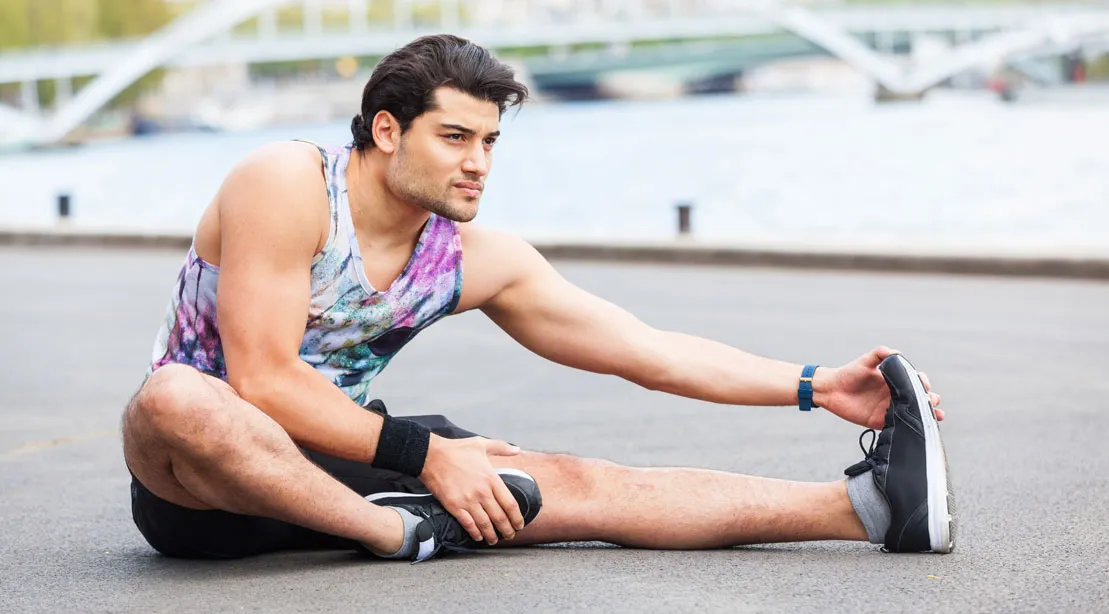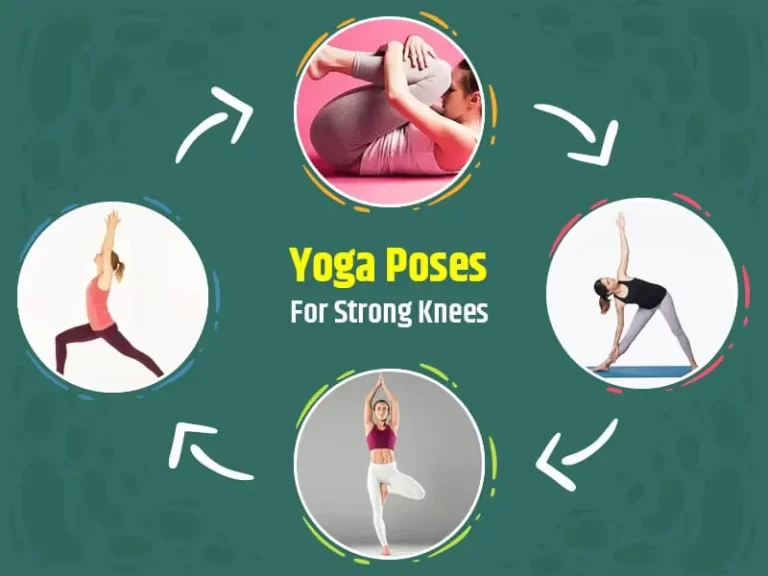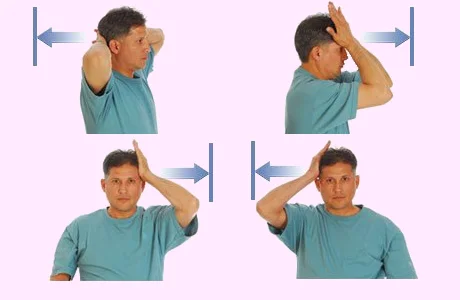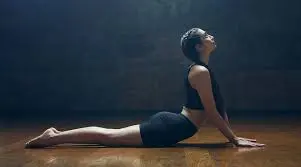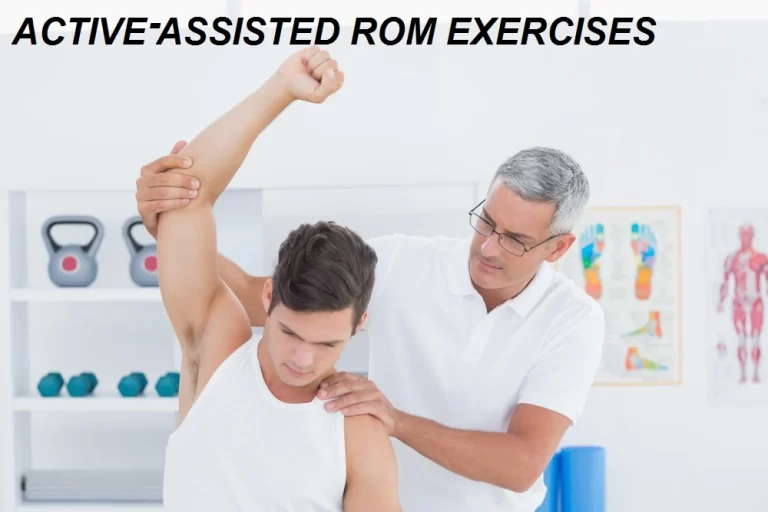25 Best Foot Muscle Exercises
Overview
- Foot Muscle exercises can help prevent foot or ankle pain while also strengthening and increasing flexibility. Activities that may be beneficial include big toe stretches, toe splays, Achilles stretches, and sand walking.
- Regular exercise and stretching of the feet and ankles can help ensure that the muscles provide adequate support. These exercises may also improve the range of motion in the feet, allowing a person to remain active for as long as possible.
- The majority of foot exercises are simple and do not require any complicated equipment to perform. People can do them at home or at the gym as part of a regular exercise regimen.
- Regular foot exercise not only improves overall foot health, but it may also reduce your risk of injury.
- Warm up by marching in place for a few minutes before going for a walk or any other exercise. Then, perform some of the rapid exercises listed below for stretching and fortifying the muscles in your feet. Then hit the road, starting slowly if this is your first time exercising in a while.
Why do Foot Muscle exercises matter?
- Keeping your feet strong and flexible can help you avoid ankle and foot pain, reduce muscle soreness, improve your overall foot health, and stay active.
- Exercises that enhance your range of motion and limber up your feet may reduce your risk of injury. Slow and gentle stretches will help you gain flexibility. Strength exercises will help your muscles provide more support and protection for your entire foot.
- You can perform these gentle strengthening and stretching exercises three times per week or every day to improve your range of motion as well as your strength for lifelong foot health and vitality.
- If your feet and ankles ache a lot, you have an injury, or you have arthritis or diabetes, consult your doctor or physical therapist before beginning any of these exercises. Depending on your needs, your doctor may suggest additional exercises or remove some of the ones listed here.
- Everyone has foot or ankle pain at some point. Keeping the feet strong can help the patient alleviate the soreness, reduce foot and ankle pain, and improve overall health and flexibility.
Regular exercise as well as stretching of the ankles and feet can help ensure that the muscles provide optimal support. - These exercises may also help to improve the range of motion in the feet and keep the patient active for as long as possible.
- The majority of foot exercises are simple and do not require any complicated equipment to complete. Individuals can do them at home or at the gym as part of their daily exercise routine.
- Foot exercises that improve foot flexibility and mobility while also helping to limber up the feet may reduce the risk of injury.
- Slow and gentle stretches will increase your range of motion. These exercises will allow the muscles to better support and protect the entire foot.
- The patient can do these gentle stretching and strengthening exercises three times per week or every day to improve range of motion and strength for lifelong foot health and vitality.
- If the patient’s feet and ankles are in severe pain, has any injuries, or has arthritis or diabetes, consult with a doctor or physical therapist before beginning any of these exercises. Depending on the condition, the doctor may add additional exercises or remove some of the ones listed here.
Health benefits of foot strengthening exercise
- We are maintaining the foot’s strength and flexibility.
- This exercise reduces foot and ankle pain, and muscle soreness, keeps patients active, and reduces the risk of injury.
- Improve overall foot health.
- Improve the arch of the foot—important for flat feet.
- Critical in keeping ourselves from falling.
Stretching Exercises of Foot Muscles
- You stretch your hamstrings. You stretch your quadriceps. You’re probably also stretching your back, especially after a long day at the desk. Did you know that you should also stretch your feet? If not, this is the time to begin.
- She explains that tight muscles prevent your feet from bending through their full range of motion while walking, resulting in shortened gait and balance issues.
- Stiff feet can affect the rest of your body. “Vinh Pham, a physical therapist and Myodetox founder explains that your feet are the only thing that connects you to the ground when you’re standing or walking. “How your foot communicates with the ground determines how your knee will react and how the hips will respond, all the way up [the body].” In other words, tight feet can disrupt the alignment of your knees and hips, resulting in annoying stiffness and pain.
- Of course, a good stretch can help with everyday foot aches, especially if you cram your toes into tight shoes. “Ideally, everyone should stretch their feet regularly,” says Steve Hruby, a chiropractor and the founder of Kaizen Progressive Health. He recommends stretching your feet every day if possible, but three times per week is a good place to start. Now that you understand the significance of foot stretches, here’s how to perform them.
How to Stretch Your Feet?
- Big toe stretch
- Limber up
- Bottom-of-foot stretch
- Top-of-foot stretch
- Calf and Achilles tendon stretch (runner’s stretch)
- Seated hamstring stretch
- Achilles stretches
Big toe stretch
Maintaining a full range of motion in the big toe is critical. The following exercise, which has three stages, is intended to stretch and relieve toe pain caused by tight shoes.
How to Perform this Exercise:
- Sit upright in your chair, feet straight on the floor.
- Allow the left foot to rest on the right thigh.
- Use your fingers to gently move the big toe up, down, and to the side.
- Keep the big toe in every position for five seconds.
- Repeat ten times before switching to the other foot.
Limber up
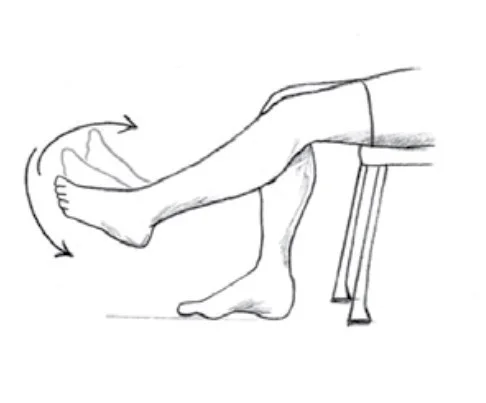
To limber up the foot before trying other exercises, do this:
- How to perform this Exercise: Sit in a chair, feet flat on the floor.
- Lift your left leg so that your foot is off the ground, then use your big toe to make clockwise circles in the air for 15-20 rotations.
- Reverse the direction and make another 15 to 20 circles in a counterclockwise direction.
- Repeat with the right foot.
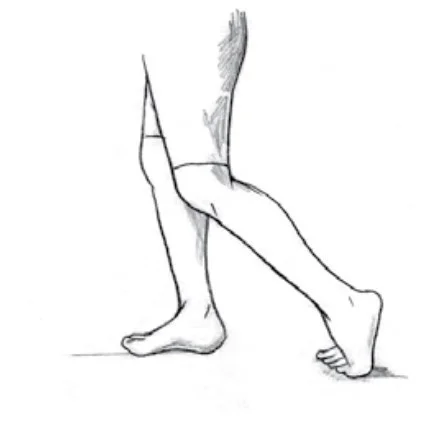
Bottom-of-foot stretch
Stretch the muscles on the bottoms of your feet and toes:
- How to perform this Exercise: Stand with your feet together.
- Step back with your left leg, heel raised and toes pressed against the ground. You should feel the muscles on the bottoms of your feet pulling gently.
- Hold for 20-30 seconds.
- Repeat with the right foot.
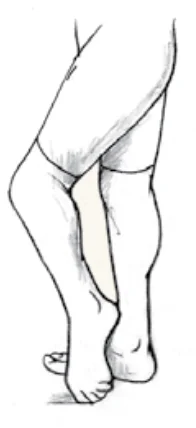
Top-of-foot stretch
- How To perform this Stretch: To stretch the muscles at the top of your feet and toes:
- Stand with your feet together.
- Being involved with one foot at a time, raise your heel as well as curl your toes under, pressing the tops of your toes into the floor.
- You should feel the muscle groups on the top of your feet and the front of the ankle gently stretching.
- Hold for 20-30 seconds.
- Repeat with the other foot.
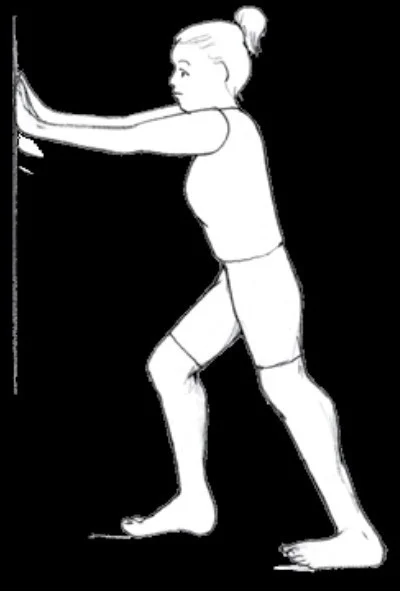
Calf and Achilles tendon stretch (runner’s stretch)
- How To perform this stretch: Stand at arm’s length from a wall, with your hands against it and your feet together.
- Step back with your left leg, slightly bending your right knee and leaving the left heel on the ground.
- You should feel a stretch from your calves to your ankles. Hold for 20-30 seconds.
- Repeat with the right leg.
Seated hamstring stretch
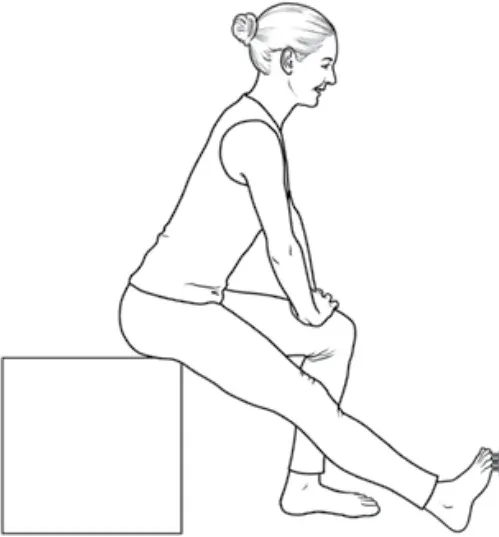
Tight muscles in the back of your thighs can put strain on the calves, which in turn affects the ankles and feet. To stretch your hamstrings:
- How To perform this stretch: Find a stable chair that does not have wheels and sit with your knees bent as well as your feet flat on the ground.
- Extend the other leg straight to front of you, with the heel on the floor and toes pointing to the ceiling.
- Hinge forward at the hip and rest your hands on your left thigh for support.
- Repeat with the left leg.
Achilles stretches
The Achilles tendon is a cord that connects your heel to your calf muscles. Keeping it flexible may assist you avoid foot, ankle, as well as leg pain.
- How To perform this stretch: Stand in front of a wall, arms extended and palms on the wall.
- Place one foot behind you, knee straight, and bend the knee of your other leg.
- Adjust your stance until both of your heels are flat on the ground.
- Lean methodology forward from the hips until you feel a stretch in the Achilles tendon and calves.
- Adjust your stance as needed to feel the pull while keeping your heels on the ground.
- To feel the stretch in a different spot, slightly bend your back knee and push your hips forward.
- Hold each stretch for thirty seconds. then repeat three times.
- Switch legs as well as repeat.
Strengthening Exercises for Foot Muscles
- Toe raise, point, and curl
- Toe splay
- Toe extension
- Toe curls
- Marble pickup
- Tennis ball roll
- Sand walking
- Big Toe Press
- Leg Swing
- Calf Raise to Big Toe Press
- Heel Raises
- Ankle Rotations
- Ice bottle massage exercise
- Flexors strengthening with a theraband
- Extensors strengthening with the band
- Inversor strengthening with the band
- Eversors strengthening exercise with the use of the band
- Tennis ball roll
Toe raise, point, and curl
This exercise has three stages as well as will help strengthen the entire foot and toes.
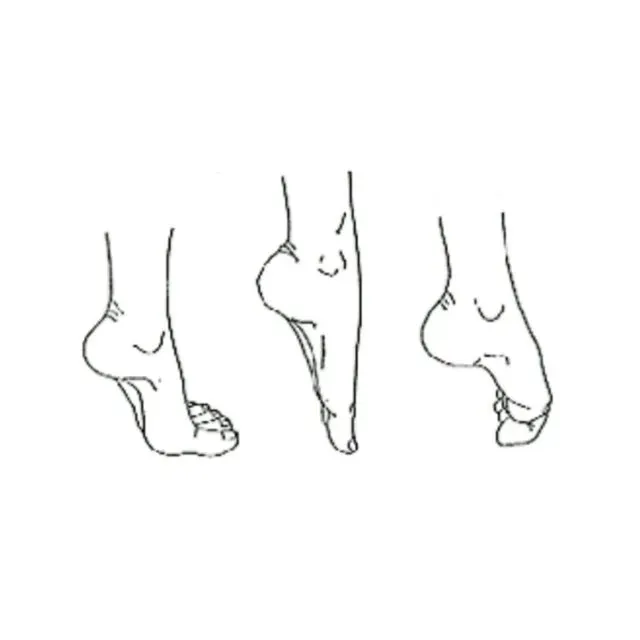
- How To perform this Exercise: Sit up straight in your chair, feet flat on the floor.
- Raise the heels while keeping the toes on the floor. Stop while only the balls of the feet are touching the ground.
- Hold the position for five seconds before lowering the heels.
- For the second stage, raise the heels as well as point the toes so that only the tips of the big and second toes touch the ground.
- Hold for five seconds before lowering. For this third stage, raise the heels and curl the toes inward, leaving only the tips of the toes touching the floor.. Hold this position for five seconds.
- Increase mobility as well as flexibility by repeating each stage ten times.
Toe splay
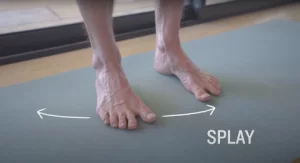
- How To perform this Exercise: This exercise helps patients gain control of their toe muscles.
- For this exercise, the patient must sit in a back-supported chair with their foot on the floor.
- Spread all of your toes as far apart as is comfortable.
- Hold for seven seconds in a single repetition. Perform ten repetitions in one session. Do two sets of two sessions each day.
- The patient can make the exercise more difficult by wrapping the resistance band around the toes of each foot.
Toe extension
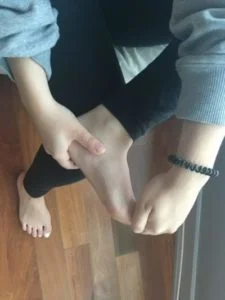
This strengthening exercise can help prevent or treat plantar fasciitis, a condition that causes heel pain.
- How To perform this Exercise: For this exercise, a patient must sit in a back-supported chair with their foot on the floor.
- Pick up the right foot and place it on the left thigh.
- With one hand, pull the toes up toward the ankle until the patient feels a stretch together the bottom of the foot and the heel cord.
- While performing this exercise, use your right hand to massage the arch of your foot. Hold for 10-15 seconds.
- Repeat ten times on each foot per session. Do two sessions per day.
Toe curls
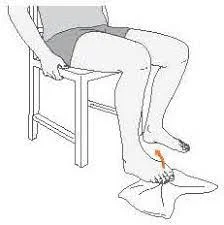
Toe curls are an effective exercise for strengthening the muscles in the upper feet and toes.
- How To perform this Exercise: For this exercise, the patient must sit in a back-supported chair with their foot on the floor.
- Place one napkin on the floor in front of you with the short end at your feet.
- Place the toes of one foot on the end of the napkin and scrunch them to pull the napkin toward you.
- Repeat five times for each foot. The patient can increase the difficulty of this exercise by placing a small weight (such as a can of soup) on the far end of the napkin.
Marble pickup
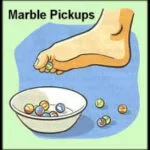
The marble pickup exercise strengthens the muscles on the bottom of the feet and toes.
- How To perform this Exercise: For this exercise, the patient must sit in a back-supported chair with their foot on the floor.
- Place 25 marbles and a small bowl on the floor in front of you.
- Pick up a single stone at a time with your toes as well as place it in the bowl. Use one foot to collect all 25 marbles.
- Repeat with the other foot.
Tennis ball roll
Strengthening exercises can help treat plantar fasciitis and arch pain. Rolling the hardball with the bottom foot.
Rolling the bottom of the foot on the hardball can help relieve arch pain and treat plantar fasciitis.
- How To perform this Exercise: For this exercise, the patient must sit in a back-supported chair with their foot on the floor.
- Put a tennis ball on the floor near your feet.
- Put the foot on top of a tennis ball and roll it around to massage the bottom of the foot.
- Increase or decrease the pressure as needed.
- Roll your feet for three minutes each.
- If the patient does not have any tennis balls, he can use a frozen bottle of water instead.

Sand walking
- How to Perform This Sand Walking Strengthening Exercise:
- Barefoot walking in the sand strengthens and stretches both the feet and the toes, and it provides the best calf workout.
- Walking in sand is more beneficial to the muscles than walking on hard surfaces, so make sure the patient turns around before he exhausts himself.
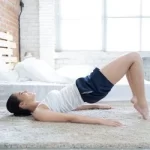
Big Toe Press
- How To perform this Exercise: To do this strengthening exercise, press the big toe into the floor while lifting the other four toes.
- Hold each press for 6 seconds and do 10-15 repetitions on each foot.
- Practice ten times per set. Do three sets per session. Perform two sessions per day.
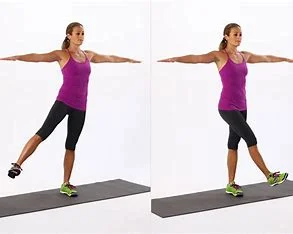
Leg Swings
- How To perform this Exercise: Perform small-amplitude leg swings to challenge balance, ankle, and hip stability.
- Stand on one leg in bare feet and adopt the short foot posture.
- Move the non-stance leg ahead and back ten times.
- Without resting, swing the same leg left and right in front of the stance leg ten times.
- Repeat this sequence without resting, then repeat with the other leg.
Calf Raise to Big Toe Press
- How To perform this Exercise: The patient must stand on the edge of a stair barefoot.
- The heels fall below the level of a staircase.
- First, the patient must perform a basic calf raise, followed by pressing the big toe. This will put your foot muscles to the test.
- Feel free to hold something for balance.
- Do 10-15 repetitions in a single session. Do two sessions per day.
Heel Raises
- How to Perform this Exercise: To begin, this strengthening exercise can be performed both at home and in the clinic; a patient should stand near a wall or a chair against which to balance.
- Slowly raise the left foot back, bringing the lower leg to a 90-degree angle. Hold for ten seconds, then return to the embarking position.
- Repeat five times with each leg in a single session. Do two sessions per day.
Ankle Rotations
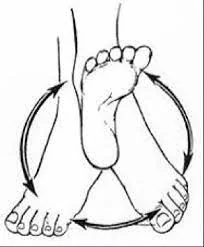
- How To perform this Exercise: First, raise your foot approximately twenty inches off the floor.
- Then, with the toe up, rotate the foot to the left and then back to the right.
- grasp for ten seconds and then return to the position from which you started.
- Perform ten times for each leg in a single session. Do three sessions per day.
Ice bottle massage exercise
- How To perform this Exercise: It is the most effective exercise for cooling down. The patient would need to prepare the plastic bottle by filling it with water and freezing it overnight.
- To complete the exercise routine:
- Tell the patient to put the frozen water bottle on the floor. After that, roll your foot over it for one to two minutes, three times per day.
- Always keep your foot moving, but don’t let the bottle rest in one spot. If a cold causes discomfort, a patient can also place a kitchen towel between the bottle and their foot.
- If you experience pain or a prickly sensation, stop and avoid this exercise.
Flexors strengthening with a theraband
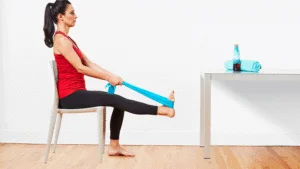
- How To perform this Exercise: To begin, the therapist should instruct the patient to sit in the chair and tie the band around a solid surface that will not move, such as a heavy table.
- Extend the lower leg and wrap the opposite end of the theraband around the top of the foot.
- Do flexion of the foot while the band resists movement. Hold for ten seconds. Repeat ten times during one session.
- Do two strengthening sessions per day. After 5 to 6 days, increase the weight from 500 gm to 1 kg and increase the repetitions.
Extensors strengthening with the band
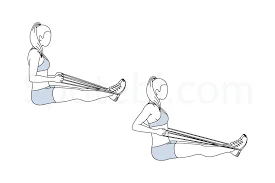
- How To perform this Exercise: To begin, instruct a patient to sit in the chair.
- After that, hold one side of the band in each hand and wrap it around the ball of the injured foot while stretching the leg out in front of you.
- Next, extend the foot away from your face. grasp this position for the next ten seconds. Repeat ten times per session. Do three sessions per day.
Inversor strengthening with theraband
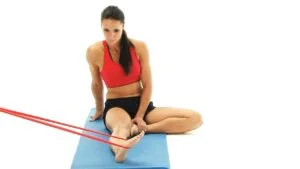
- How To perform this Exercise: Begin by tying the theraband around the leg of the chair or a table on the same side as the injured foot.
- Then, wrap the other end of the theraband near the inside of the affected foot.
- After that, try turning the foot inside. Maintain that position for the next 10 seconds.
- Do two sessions per day. When the patient has adapted to the 500gm weight, improve the weight to 1 kg and increase the repetitions.

Eversors Strengthening Exercise Using the Band
- How To perform this Exercise: To begin, tie a theraband around the leg of the chair opposite the affected foot.
- Next, wrap the other end near the outside of the affected foot. Next, the physical therapist should instruct the patient to turn their foot outside and hold for ten seconds before repeating the exercise ten times per session.
- Do two sessions as well as three sets each day. When the person has adapted to the 500-gram weight, raise it to one kilogram and increase the repetitions.
Ankle Alphabet
This helps to strengthen the four main muscles in your lower leg.
- How To perform this Exercise: Sit up straight in a chair, feet flat on the floor.
- Extend your left leg in front of you, toes pointing to the ceiling.
- Draw the alphabet with your big toe.
- Repeat twice, then switch to the other leg.
Foot Health and Safety Tips
To keep your feet strong and healthy:
- Before you begin exercising, complete a thorough warmup routine.
- Wear supportive footwear during daily activities and sports.
- Replace worn-out shoes as frequently as possible.
- Increase strength and flexibility gradually to condition the feet and ankles.
- Avoid uneven surfaces, especially while running. Try not to run uphill too much.
- Listen to your body. Avoid overdoing activities.
- Rest and seek appropriate treatment to prevent the recurrence of the injury.
Summary
- Keeping your feet and ankles healthy is a good idea. Performing the exercises listed above can help relieve existing pain, prevent discomfort, as well as lower the risk of injury.
- People who have been diagnosed with a foot condition, such as plantar fasciitis or Achilles tendon strain, may benefit from exercises.
- Always consult with a healthcare professional before beginning a new exercise and stretching routine.
- Regularly performing these foot stretches and strengthening exercises will benefit your feet. The stiffness and aches will ease. The exercises can help relieve heel and arch pain, prevent hammertoes, and stop toe cramps.
- Warm up before starting your foot exercises. Walk around the house for a few minutes or use a stationary bike. You want to get some blood flowing before stretching your tendons, ligaments, and muscles.
- The exercises and stretches should not be painful. Be gentle with yourself. You could be pressing too hard against the tennis ball or stretching too far. Relax a bit.
- If it still hurts, stop exercising and consult your doctor or physical therapist about how to proceed. If any of the instructions are unclear or do not appear to be addressing your problem, contact your doctor for assistance.
FAQs
What causes weakened foot muscles?
The most common cause of foot drop is compression of a nerve in the leg that controls the muscles responsible for lifting the foot. This nerve is called the peroneal nerve. A severe knee injury can cause nerve compression. It can also be injured during a knee or hip replacement surgery, which may result in foot drop
Will exercise relieve foot pain?
After any foot problem, it is critical to regain movement and strength. This promotes tissue healing and allows you to resume physical activity. You may not be able to resume your normal exercise levels right away, and progress may be slow at first.
Does walking relieve foot pain?
Shorter walks help relax tight muscles and improve recovery time between harder walks. Changing up your walking route can also reduce pain and increase strength gains.
Why should you strengthen your feet?
Strengthening the intrinsic muscles of the feet has significant implications for lowering the risk of lower extremity injuries as well as improving arch stability. These small muscles are frequently overlooked, despite playing an important role in health and mobility.
Can walking help strengthen your feet?
Exercising your feet regularly not only improves overall foot health but can also decrease the risk of injury. Walking is the most effective overall foot exercise. When you walk, your foot moves through its entire range of motion, from the moment your heel hits the ground until you lift off with your toes.
What causes a weakened foot?
Foot drop is caused by paralysis or weakness of the muscles responsible for lifting the front of the foot. Nerve injury is one possible cause of foot drop. Foot drop is most commonly caused by the compression of a nerve in the leg that controls the muscles involved in lifting the foot
REFERENCES
- Exercises and stretches to keep your feet healthy. (2022, February 2). Harvard Health. https://www.health.harvard.edu/staying-healthy/exercises-and-stretches-for-foot-health
- Steber, C. (2024, February 20). Foot Stretch Benefits & Examples, According To Experts. Bustle. https://www.bustle.com/wellness/foot-stretch-benefits-examples-experts\
- Prajapati, N. (2022, December 12). Foot muscle strengthening exercises – Health Benefits, How to do? Samarpan Physiotherapy Clinic. https://samarpanphysioclinic.com/foot-muscle-strengthening-exercises/
- Villines, Z. (2023, October 24). Best stretches and exercises for plantar fasciitis and heel pain. https://www.medicalnewstoday.com/articles/324353#seated-foot-stretch
- Axtell, B. (2018, February 27). 9 Foot Exercises to Try at Home. Healthline. https://www.healthline.com/health/fitness-exercise/foot-exercises#tennis-ball-roll
- Birmingham, F. S. O. (2021, March 9). 9 Exercises to Keep Your Feet Strong and Flexible. Foot Specialists of Birmingham. https://bhamfoot.com/9-exercises-to-keep-your-feet-strong-and-flexible/

